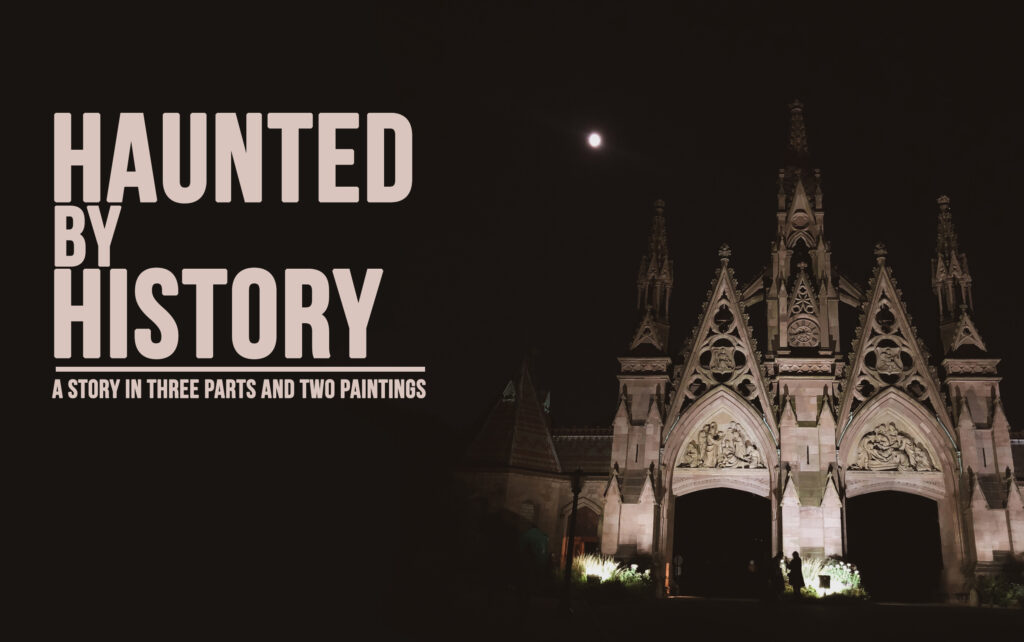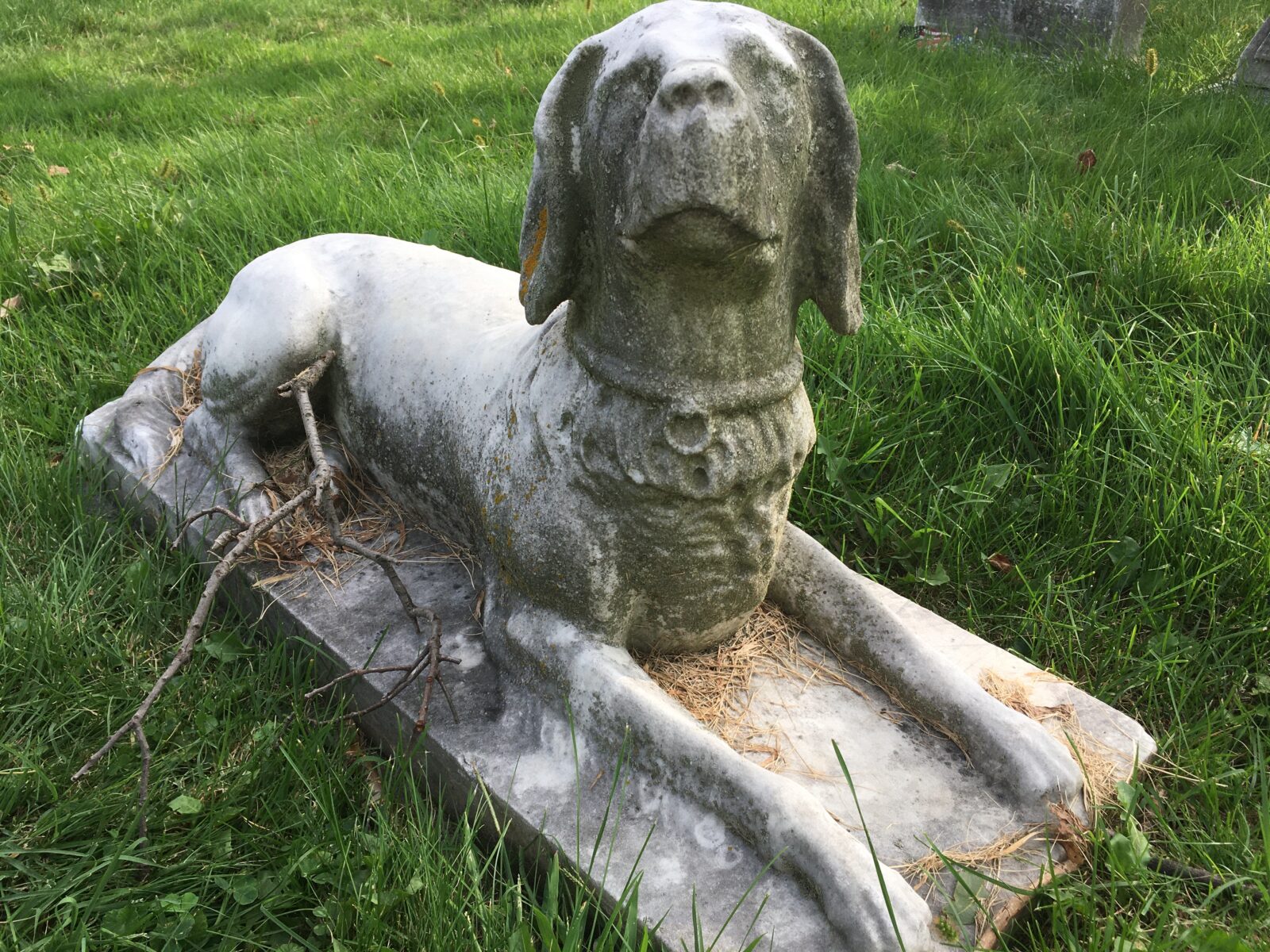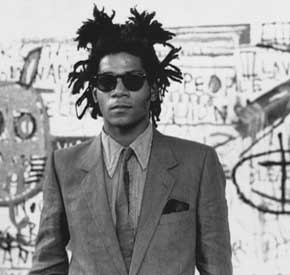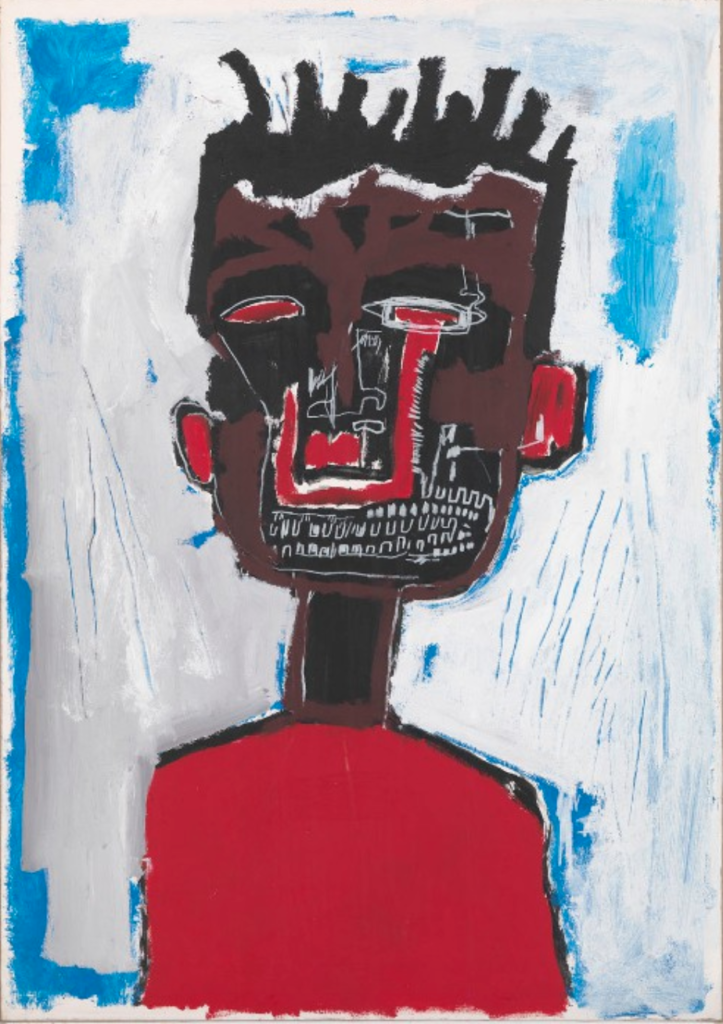The Tenement Museum’s Jason Eisner and his daughter return to Green-Wood Cemetery, and in the process of aiding a few people in their search for the grave of artist Jean-Michel Basquiat, uncover a haunting moment in Lower East Side history. A story told in three parts and two paintings.
Great Reads, New York City History
Haunted by History Part I: Lost Souls
October 14, 2020

“You know, at night that stone dog comes to life? It stands and stretches and then starts to run around after anyone who thinks it’s cool to break into the cemetery. That’s right. Anyone in here after dark who’s not supposed to be is going to have to answer to the ghost of the stone dog!”
The serious look on my daughter’s face lingers for a minute and breaks with a sweet laugh. “Go-go!” she says, as she pats the dog. They are good friends. To her, the dog is already alive.

But she is suddenly distracted by something behind me. Her look turns serious again, and I hear soft footsteps approaching. Turning around I see two white figures drifting in our direction. A chilly fall breeze blows through them and rattles the leaves around us. I know what they want. I know what they’re looking for.
They are searching for the grave of Jean-Michel Basquiat, buried nearby. I’ve seen these wandering spirits many times before – their wrinkled cemetery maps and forlorn expressions. Being lost is hard enough, but being lost in a cemetery takes on a supernatural quality. I too must have looked this haunted in my search for Lucas Glockner, the first landlord of 97 Orchard Street, a five-floor tenement house on Manhattan’s Lower East Side.
Condemned as a residence in 1935, 97 Orchard enjoyed an extended life as a commercial building, supporting four storefronts. The residential units above the first floor were left frozen in time – shelf paper lining the empty cabinets, forgotten chairs and tubs catching broken fragments of plaster, curtains pinned to window molding, slowly turning black. Even the dust particles seemed suspended midair in this haunted house – until 1988, when Anita Jacobson disturbed them. 1988 marked the end of Ruth Abram and Anita Jacobson’s search for a Pre-Law tenement house from which they would launch their radical history project… and so the Tenement Museum was born.

On August 12, of that year Jean-Michel Basquait was found dead in his downtown studio. His death also represents an end and a beginning- the artist gone and the Basquiat mythology born. Basquiat cultivated this myth himself- the teenage runaway who drifted into the Lower East Side and Downtown underground club scene, the poetic and ironic street artist, the punk prophet who painted in designer suits and wrought his vision of the world into irresistible narrative imagery on any and every surface he could find.
His career as an art maker lasted little more than a decade… but his career as a cultural figure continues to pulse. It beacons admirers of all ages to the south-western quadrant of Green-Wood Cemetery, like moths to the flame.
Here come two moths now, gravitating to my daughter and I – the living – in hopes of completing their tribute to the dead. Basquiat has been dead for 32 years, five more than he lived. During this time, his myth has taken on a life of its own. I can’t help but wonder… is Basquiat haunted by his posthumous living persona?
A mid-career painting bursts into my mind: “Self Portrait,” painted in 1984. It is a bold statement of identity rendered in black, brown, red, blue and white. The mythical Basquiat emanates from this image, like a shameless self-promotion, interrupting a deeper read. I want to be in conversation with this image, not Basquiat’s loud ghost. Like the curator Chaédria LaBouvier, I’m looking for the human beneath the superhero. I begin by asking questions.
Quietly Basquiat’s “Self Portrait” answers; it speaks in brush strokes and visual language.

Self-portrait, 1984 © The Estate of Jean-Michel Basquiat/ADAGP, Paris, ARS, New York 2013
There is a disquieting sense of loneliness in this image. Looking at all four edges of the painting, there is not a single mark or form moving beyond the frame. The result is a tense, amorphous barrier separating Basquiat from me. Is this a form of protection, allowing me to see him but preventing me from getting too close? Is he trapped in the painting? Is he speaking to the limits of his freedom and inclusion as a Black artist in a white centered culture? The Downtown Art Scene of the 1980s was arguably more diverse than the established scene, Basquiat was still a token.
How is Basquiat speaking in this image? Under his nose are two red marks forming the pursed lips of a kiss. Under that, an odd red mark extends down from his left eye like a trail of blood. And under that, stretching across the length of his face, are rows and rows of teeth. This Basquiat has a lot to say. Do I have to get beyond the wound to hear his story? Was he wounded because he spoke out? Did I inflict the wound?
Basquiat painted himself in black and brown with red eyes, ears and lips. He is wearing a red shirt, and he’s being thrust forward by a dense gestural field of blue and white. He is the black and brown in a painting otherwise dominated by the colors of the American flag. This self-portrait, with its color palate and ambiguous visual forces, suggest Basquiat’s self-reflective meditation on being a Black man in the United States.
“Excuse me.”
A voice from beyond abruptly ends my conversation with Basquiat. The two lost Basquiat fans are now standing six feet away from us. The one clutching the map is wearing a tee-shirt emblazoned with Basquiat’s iconic crown. “Can you help us?”
Looking over at my daughter I see her patting the ghost dog’s hind quarters to say goodbye. “We know the way,” I tell them. “Follow us.”
Stay tuned for Part Two
Self-portrait, 1984 © The Estate of Jean-Michel Basquiat/ADAGP, Paris, ARS, New York 2013